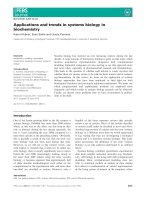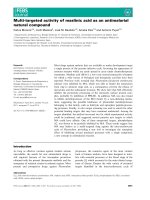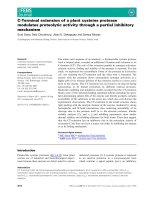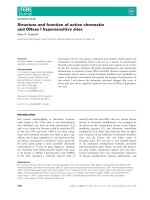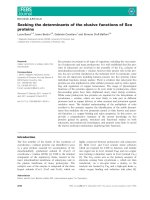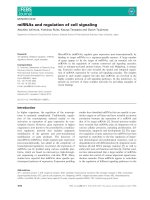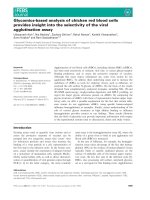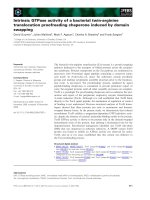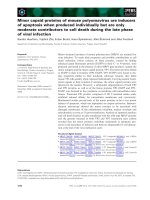Tài liệu Báo cáo khoa học: "Generating Fine-Grained Reviews of Songs From Album Reviews" doc
Bạn đang xem bản rút gọn của tài liệu. Xem và tải ngay bản đầy đủ của tài liệu tại đây (316.92 KB, 10 trang )
Proceedings of the 48th Annual Meeting of the Association for Computational Linguistics, pages 1376–1385,
Uppsala, Sweden, 11-16 July 2010.
c
2010 Association for Computational Linguistics
Generating Fine-Grained Reviews of Songs From Album Reviews
Swati Tata and Barbara Di Eugenio
Computer Science Department
University of Illinois, Chicago, IL, USA
{stata2 | bdieugen}@uic.edu
Abstract
Music Recommendation Systems often
recommend individual songs, as opposed
to entire albums. The challenge is to gen-
erate reviews for each song, since only full
album reviews are available on-line. We
developed a summarizer that combines in-
formation extraction and generation tech-
niques to produce summaries of reviews of
individual songs. We present an intrinsic
evaluation of the extraction components,
and of the informativeness of the sum-
maries; and a user study of the impact of
the song review summaries on users’ de-
cision making processes. Users were able
to make quicker and more informed deci-
sions when presented with the summary as
compared to the full album review.
1 Introduction
In recent years, the personal music collection of
many individuals has significantly grown due to
the availability of portable devices like MP3 play-
ers and of internet services. Music listeners are
now looking for techniques to help them man-
age their music collections and explore songs they
may not even know they have (Clema, 2006).
Currently, most of those electronic devices follow
a Universal Plug and Play (UPNP) protocol (UPN,
2008), and can be used in a simple network, on
which the songs listened to can be monitored. Our
interest is in developing a Music Recommendation
System (Music RS) for such a network.
Commercial web-sites such as Amazon (www.
amazon.com) and Barnes and Nobles (www.
bnn.com) have deployed Product Recommen-
dation Systems (Product RS) to help customers
choose from large catalogues of products. Most
Product RSs include reviews from customers who
bought or tried the product. As the number of
reviews available for each individual product in-
creases, RSs may overwhelm the user if they make
all those reviews available. Additionally, in some
reviews only few sentences actually describe the
recommended product, hence, the interest in opin-
ion mining and in summarizing those reviews.
A Music RS could be developed along the lines
of Product RSs. However, Music RSs recom-
mend individual tracks, not full albums, e.g. see
www.itunes.com. Summarizing reviews be-
comes more complex: available data consists of
album reviews, not individual song reviews (www.
amazon.com, www.epinions.com). Com-
ments about a given song are fragmented all over
an album review. Though some web-sites like
www.last.fm allow users to comment on indi-
vidual songs, the comments are too short (a few
words such as “awesome song”) to be counted as
a full review.
In this paper, after presenting related work and
contrasting it to our goals in Section 2, we discuss
our prototype Music RS in Section 3. We devote
Section 4 to our summarizer, that extracts com-
ments on individual tracks from album reviews
and produces a summary of those comments for
each individual track recommended to the user.
In Section 5, we report two types of evaluation: an
intrinsic evaluation of the extraction components,
and of the coverage of the summary; an extrinsic
evaluation via a between-subject study. We found
that users make quicker and more informed deci-
sions when presented with the song review sum-
maries as opposed to the full album review.
2 Related Work
Over the last decade, summarization has become
a hot topic for research. Quite a few systems were
developed for different tasks, including multi-
document summarization (Barzilay and McKe-
own, 2005; Soubbotin and Soubbotin, 2005; Nas-
tase, 2008).
1376
What’s not to get? Yes, Maxwell, and Octopus are a
bit silly!
“Something” and “Here Comes The Sun” are two of
George’s best songs ever (and “Something” may be
the single greatest love song ever). “Oh Darling” is
a bluesy masterpiece with Paul screaming
“Come Together” contains a great riff, but he ended up
getting sued over the lyrics by Chuck Berry
Figure 1: A sample review for the album “Abbey Road”
Whereas summarizing customer reviews can
be seen as multi-document summarization, an
added necessary step is to first extract the most
important features customers focus on. Hence,
summarizing customer reviews has mostly been
studied as a combination of machine learning
and NLP techniques (Hu and Liu, 2004; Ga-
mon et al., 2005). For example, (Hu and Liu,
2004) use associative mining techniques to iden-
tify features that frequently occur in reviews
taken from www.epinions.com and www.
amazon.com. Then, features are paired to the
nearest words that express some opinion on that
feature. Most work on product reviews focuses
on identifying sentences and polarity of opinion
terms, not on generating a coherent summary from
the extracted features, which is the main goal
of our research. Exceptions are (Carenini et al.,
2006; Higashinaka et al., 2006), whose focus was
on extracting domain specific ontologies in order
to structure summarization of customer reviews.
Summarizing reviews on objects different from
products, such as restaurants (Nguyen et al.,
2007), or movies (Zhuang et al., 2006), has also
been tackled, although not as extensively. We
are aware of only one piece of work that focuses
on music reviews (Downie and Hu, 2006). This
study is mainly concerned with identifying de-
scriptive patterns in positive or negative reviews
but not on summarizing the reviews.
2.1 Summarizing song reviews is different
As mentioned earlier, using album reviews for
song summarization poses new challenges:
a) Comments on features of a song are embed-
ded and fragmented within the album reviews, as
shown in Figure 1. It is necessary to correctly map
features to songs.
b) Each song needs to be identified each time it
is referred to in the review. Titles are often ab-
breviated, and in different ways, even in the same
review – e.g. see Octopus for Octopus’s Garden
in Figure 1. Additionally, song titles need not be
noun phrases and hence NP extraction algorithms
miss many occurrences, as was shown by prelimi-
nary experiments we ran.
c) Reviewers focus on both inherent features such
as lyrics, genre and instruments, but also on people
(artist, lyricist, producer etc.), unlike in product
reviews where manufacturer/designer are rarely
mentioned. This variety of features makes it
harder to generate a coherent summary.
3 SongRecommend: Prototype Music RS
Figure 2 shows the interface of our prototype Mu-
sic RS. It is a simple interface dictated by our fo-
cus on the summarization process (but it was in-
formed by a small pilot study). Moving from win-
dow to window and from top to bottom:
a) The top leftmost window shows different de-
vices on which the user listens to songs. These
devices are monitored with a UPNP control point.
Based on the messages received by the control
point, the user activities, including the metadata
of the song, are logged.
b) Once the user chooses a certain song on one of
the devices (see second window on top), we dis-
play more information about the song (third top
window); we also identify related songs from the
internet, including: other songs from the same al-
bum, popular songs of the artist and popular songs
of related artists, as obtained from Yahoo Music.
c) The top 25 recommendations are shown in the
fourth top window. We use the SimpleKMeans
Clustering (Mitchell, 1997) to identify and rank
the top twenty-five songs which belong to the
same cluster and are closest to the given song.
Closeness between two songs in a cluster is mea-
sured as the number of attributes (album, artist etc)
of the songs that match.
d) When the user clicks on More Info for one of
the recommended songs, the pop-up, bottom win-
dow is displayed, which contains the summary of
the reviews for the specific song.
4 Extraction and Summarization
Our summarization framework consists of the five
tasks illustrated in Figure 3. The first two tasks
pertain to information extraction, the last three to
repackaging the information and generating a co-
1377
Figure 2: SongRecommend Interface
Figure 3: Summarization Pipeline
herent summary. Whereas the techniques we use
for each individual step are state-of-the-art, our ap-
proach is innovative in that it integrates them into
an effective end-to-end system. Its effectiveness is
shown by the promising results obtained both via
the intrinsic evaluation, and the user study. Our
framework can be applied to any domain where
reviews of individual components need to be sum-
marized from reviews of collections, such as re-
views of different hotels and restaurants in a city.
Our corpus was opportunistically col-
lected from www.amazon.com and
www.epinions.com. It consists of 1350
album reviews across 27 albums (50 reviews
per album). 50 randomly chosen reviews were
used for development. Reviews have noise, since
the writing is informal. We did not clean it, for
example we did not correct spelling mistakes.
This corpus was annotated for song titles and song
features. Feature annotation consists of marking
a phrase as a feature and matching it with the song
to which the feature is attributed. Note that we
have no a priori inventory of features; what counts
as features of songs emerged from the annotation,
since annotators were asked to annotate for noun
phrases which contain “any song related term or
terms spoken in the context of a song”. Further,
they were given about 5 positive and 5 negative
1378
What’s not to get? Yes, <song
id=3>Maxwell</song>, and <song
id=5>Octopus</song> are a bit silly!
<song id=2>“Something”</song> and <song
id=7>“Here Comes The Sun”</song> are two of
<feature id=(2,7)>George’s</feature> best songs
ever (and <song id=2>“Something”</song> may be
<song id=4>“Oh Darling”</song> is a <feature
id=4>bluesy masterpiece</feature> with <feature
id=4>Paul</feature> screaming
<song id=1>“Come Together”</song> contains a
great <feature id=1>riff</feature>, but
Figure 4: A sample annotated review
examples of features. Figure 4 shows annotations
for the excerpt in Figure 1. For example in
Figure 4, George, Paul, bluesy masterpiece and
riff have been marked as features. Ten randomly
chosen reviews were doubly annotated for song
titles and features. The Kappa co-efficient of
agreement on both was excellent (0.9), hence the
rest of the corpus was annotated by one annotator
only. The two annotators were considered to be in
agreement on a feature if they marked the same
head of phrase and attributed it to the same song.
We will now turn to describing the component
tasks. The algorithms are described in full in (Tata,
2010).
4.1 Title Extraction
Song identification is the first step towards sum-
marization of reviews. We identify a string of
words as the title of a song to be extracted from
an album review if it (1) includes some or all the
words in the title of a track of that album, and (2)
this string occurs in the right context. Constraint
(2) is necessary because the string of words cor-
responding to the title may appear in the lyrics of
the song or anywhere else in the review. The string
Maxwell’s Silver Hammer counts as a title only in
sentence (a) below; the second sentence is a verse
in the lyrics:
a. Then, the wild and weird “Maxwell’s Silver
Hammer.”
b. Bang, Bang, maxwell’s silver hammer cam
down on her head.
Similar to Named Entity Recognition (Schedl et
al., 2007), our approach to song title extraction
is based on n-grams. We proceed album by al-
bum. Given the reviews for an album and the list
of songs in that album, first, we build a lexicon of
all the words in the song titles. We also segment
the reviews into sentences via sentence boundary
detection. All 1,2,3,4-grams for each sentence (the
upper-bound 4 was determined experimentally) in
the review are generated. First, n-grams that con-
tain at least one word with an edit distance greater
than one from a word in the lexicon are filtered
out. Second, if higher and lower order n-grams
overlap at the same position in the same sentence,
lower order n-grams are filtered out. Third, the
n-grams are merged if they occur sequentially in
a sentence. Fourth, the n-grams are further fil-
tered to include only those where (i) the n-gram is
within quotation marks; and/or (ii) the first char-
acter of each word in the n-gram is upper case.
This filters n-grams such as those shown in sen-
tence (b) above. All the n-grams remaining at this
point are potential song titles. Finally, for each
n-gram, we retrieve the set of IDs for each of its
words and intersect those sets. This intersection
always resulted in one single song ID, since song
titles in each album differ by at least one content
word. Recall that the algorithm is run on reviews
for each album separately.
4.2 Feature Extraction
Once the song titles are identified in the album re-
view, sentences with song titles are used as an-
chors to (1) identify segments of texts that talk
about a specific song, and then (2) extract the fea-
ture(s) that the pertinent text segment discusses.
The first step roughly corresponds to identify-
ing the flow of topics in a review. The second step
corresponds to identifying the properties of each
song. Both steps would greatly benefit from ref-
erence resolution, but current algorithms still have
a low accuracy. We devised an approach that com-
bines text tiling (Hearst, 1994) and domain heuris-
tics. The text tiling algorithm divides the text into
coherent discourse units, to describe the sub-topic
structure of the given text. We found the relatively
coarse segments the text tiling algorithm provides
sufficient to identify different topics.
An album review is first divided into seg-
ments using the text tiling algorithm. Let
[seg
1
, seg
2
, , seg
k
] be the segments obtained.
The segments that contain potential features of a
song are identified using the following heuristics:
Step 1: Include seg
i
if it contains a song title.
1379
These segments are more likely to contain features
of songs as they are composed of the sentences
surrounding the song title.
Step 2: Include seg
i+1
if seg
i
is included and
seg
i+1
contains one or more feature terms.
Since we have no a priori inventory of features
(the feature annotation will be used for evalua-
tion, not for development), we use WordNet (Fell-
baum, 1998) to identify feature terms: i.e., those
nouns whose synonyms, direct hypernym or di-
rect hyponym, or the definitions of any of those,
contain the terms “music” or “song”, or any form
of these words like “musical”, “songs” etc, for at
least one sense of the noun. Feature terms exclude
the words “music”, “song”, the artist/band/album
name as they are likely to occur across album re-
views. All feature terms in the final set of seg-
ments selected by the heuristics are taken to be
features of the song described by that segment.
4.3 Sentence Partitioning and Regeneration
After extracting the sentences containing the fea-
tures, the next step is to divide the sentences into
two or more “sub-sentences”, if necessary. For
example, “McCartney’s bouncy bass-line is espe-
cially wonderful, and George comes in with an ex-
cellent, minimal guitar solo.” discusses both fea-
tures bass and guitar. Only a portion of the sen-
tence describes the guitar. This sentence can
thus be divided into two individual sentences. Re-
moving parts of sentences that describe another
feature, will have no effect on the summary as
a whole as the portions that are removed will be
present in the group of sentences that describe the
other feature.
To derive n sentences, each concerning a single
feature f , from the original sentence that covered
n features, we need to:
1. Identify portions of sentences relevant to each
feature f (partitioning)
2. Regenerate each portion as an independent sen-
tence, which we call f-sentence.
To identify portions of the sentence relevant to the
single feature f, we use the Stanford Typed De-
pendency Parser (Klein and Manning, 2002; de
Marnee and Manning, 2008). Typed Dependen-
cies describe grammatical relationships between
pairs of words in a sentence. Starting from the fea-
ture term f in question, we collect all the nouns,
adjectives and verbs that are directly related to it
in the sentence. These nouns, adjectives and verbs
1. “Maxwell” is a bit silly.
2. “Octopus” is a bit silly.
3. “Something” is George’s best song.
4. “Here Comes The Sun” is George’s best song.
5. “Something” may be the single greatest love song.
6. “Oh! Darling” is a bluesy masterpiece.
7. “Come Together” contains a great riff.
Figure 5: f -sentences corresponding to Figure 1
become the components of the new f-sentence.
Next, we need to adjust their number and forms.
This is a natural language generation task, specifi-
cally, sentence realization.
We use YAG (McRoy et al., 2003), a template
based sentence realizer. clause is the main tem-
plate used to generate a sentence. Slots in a tem-
plate can in turn be templates. The grammati-
cal relationships obtained from the Typed Depen-
dency Parser such as subject and object identify
the slots and the template the slots follows; the
words in the relationship fill the slot. We use a
morphological tool (Minnen et al., 2000) to ob-
tain the base form from the original verb or noun,
so that YAG can generate grammatical sentences.
Figure 5 shows the regenerated review from Fig-
ure 1.
YAG regenerates as many f-sentences from the
original sentence, as many features were contained
in it. By the end of this step, for each feature f
of a certain song s
i
, we have generated a set of
f-sentences. This set also contains every original
sentence that only covered the single feature f.
4.4 Grouping
f-sentences are further grouped, by sub-feature
and by polarity. As concerns sub-feature group-
ing, consider the following f-sentences for the
feature guitar:
a. George comes in with an excellent, minimal
guitar solo.
b. McCartney laid down the guitar lead for this
track.
c. Identical lead guitar provide the rhythmic
basis for this song.
The first sentence talks about the guitar solo, the
second and the third about the lead guitar. This
step will create two subgroups, with sentence a in
one group and sentences b and c in another. We
1380
Let [f
x
-s
1
, f
x
-s
2
, f
x
-s
n
] be the set of sentences for
feature f
x
and song S
y
Step 1: Find the longest common n-gram (LCN) be-
tween f
x
-s
i
and f
x
-s
j
for all i = j: LCN(f
x
-s
i
, f
x
-s
j
)
Step 2: If LCN(f
x
-s
i
, f
x
-s
j
) contains the feature term
and is not the feature term alone, f
x
-s
i
and f
x
-s
j
are
in the same group.
Step 3: For any f
x
-s
i
, if LCN(f
x
-s
i
, f
x
-s
j
) for all i and
j, is the feature term, then f
x
-s
i
belongs to the default
group for the feature.
Figure 6: Grouping sentences by sub-features
identify subgroups via common n-grams between
f-sentences, and make sure that only n-grams that
are related to feature f are identified at this stage,
as detailed in Figure 6. When the procedure de-
scribed in Figure 6 is applied to the three sentences
above, it identifies guitar as the longest pertinent
LCN between a and b, and between a and c; and
guitar lead between b and c (we do not take into
account linear order within n-grams, hence gui-
tar lead and lead guitar are considered identical).
Step 2 in Figure 6 will group b and c together since
guitar lead properly contains the feature term gui-
tar. In Step 3, sentence a is sentence f
x
-s
i
such
that its LCN with all other sentences (b and c) con-
tains only the feature term; hence, sentence a is
left on its own. Note that Steps 2 and 3 ensure
that, among all the possible LNCs between pair of
sentences, we only consider the ones containing
the feature in question.
As concerns polarity grouping, different re-
views may express different opinions regarding a
particular feature. To generate a coherent sum-
mary that mentions conflicting opinions, we need
to subdivide f-sentences according to polarity.
We use SentiWordNet (Esuli and Sebastiani,
2006), an extension of WordNet where each sense
of a word is augmented with the probability of
that sense being positive, negative or neutral. The
overall sentence score is based on the scores of the
adjectives contained in the sentence.
Since there are a number of senses for each
word, an adjective a
i
in a sentence is scored as the
normalized weighted scores of each sense of the
adjective. For each a
i
, we compute three scores,
positive, as shown in Formula 1, negative and ob-
Example: The lyrics are the best
Adjectives in the sentence: best
Senti-wordnet Scores of best:
Sense 1 (frequency=2):
positive = 0.625, negative =0 , objective = 0.375
Sense 2 (frequency=1):
positive = 0.75, negative = 0, objective = 0.25
Polarity Scores Calculation:
positive(best) =
2∗0.625+1∗0.75
(2+1)
= 0.67
negative(best) =
2∗0+1∗0
(2+1)
= 0
objective(best) =
2∗0.375+1∗0.25
(2+1)
= 0.33
Since the sentence conta ins only the adjective best, its
polarity is positive, from:
Max (positive(best), negative(best), objective(best))
Figure 7: Polarity Calculation
jective, which are computed analogously:
pos(a
i
) =
freq
1
∗ pos
1
+ + freq
n
∗ pos
n
(freq
1
+ + freq
n
)
(1)
a
i
is the i
th
adjective, freq
j
is the frequency of
the j
th
sense of a
i
as given by Wordnet, and pos
j
is the positive score of the j
th
sense of a
i
, as given
by SentiWordnet. Figure 7 shows an example of
calculating the polarity of a sentence.
For an f -sentence, three scores will be com-
puted, as the sum of the corresponding scores
(positive, negative, objective) of all the adjectives
in the sentence. The polarity of the sentence is de-
termined by the maximum of these three scores.
4.5 Selection and Ordering
Finally, the generation of a coherent summary in-
volves selection of the sentences to be included,
and ordering them in a coherent fashion. This step
has in input groups of f -sentences, where each
group pertains to the feature f, one of its subfea-
tures, and one polarity type (positive, negative, ob-
jective). We need to select one sentence from each
subgroup to make sure that all essential concepts
are included in the summary. Note that if there are
contrasting opinions on one feature or subfeatures,
one sentence per polarity will be extracted, result-
ing in potentially inconsistent opinions on that fea-
ture to be included in the review (we did not ob-
serve this happening frequently, and even if it did,
it did not appear to confuse our users).
Recall that at this point, most f-sentences have
been regenerated from portions of original sen-
1381
tences (see Section 4.3). Each f -sentence in a
subgroup is assigned a score which is equivalent
to the number of features in the original sentence
from which the f -sentence was obtained. The sen-
tence which has the lowest score in each subgroup
is chosen as the representative for that subgroup.
If multiple sentences have the lowest score, one
sentence is selected randomly. Our assumption is
that among the original sentences, a sentence that
talks about one feature only is likely to express a
stronger opinion about that feature than a sentence
in which other features are present.
We order the sentences by exploiting a music
ontology (Giasson and Raimond, 2007). We have
extended this ontology to include few additional
concepts that correspond to features identified in
our corpus. Also, we extended each of the classes
by adding the domain to which it belongs. We
identified a total of 20 different domains for all
the features. For example, [saxophone,drums] be-
longs to the domain Instrument, and [tone, vocals]
belong to the domain Sound. We also identified
the priority order in which each of these domains
should appear in the final summary. The order-
ing of the domains is such that first we present the
general features of the song (e.g. Song) domain,
then present more specific domains (e.g. Sound,
Instrument). f−sentences of a single domain form
one paragraph in the final summary. However, fea-
tures domains that are considered as sub-domains
of another domain are included in the same para-
graph, but are ordered next to the features of the
parent domain. The complete list of domains is de-
scribed in (Tata, 2010). f-sentences are grouped
and ordered according to the domain of the fea-
tures. Figure 8 shows a sample summary when the
extracted sentences are ordered via this method.
“The Song That Jane Likes” is cute. The song
has some nice riffs by Leroi Moore. “The Song
That Jane Likes” is also amazing funk number.
The lyrics are sweet and loving.
The song carries a light-hearted tone. It has
a catchy tune. The song features some nice ac-
cents.
“The Song That Jane Likes” is beautiful
song with great rhythm. The funky beat will
surely make a move.
It is a heavily acoustic guitar-based song.
Figure 8: Sample summary
5 Evaluation
In this section we report three evaluations, two
intrinsic and one extrinsic: evaluation of the song
title and feature extraction steps; evaluation of the
informativeness of summaries; and a user study to
judge how summaries affect decision making.
5.1 Song Title and Feature Extraction
The song title extraction and feature extraction al-
gorithms (Sections 4.1 and 4.2) were manually
evaluated on 100 reviews randomly taken from the
corpus (2 or 3 from each album). This relatively
small number is due to the need to conduct the
evaluation manually. The 100 reviews contained
1304 occurrences of song titles and 898 occur-
rences of song features, as previously annotated.
1294 occurrences of song titles were correctly
identified; additionally, 123 spurious occurrences
were also identified. This results in a precision of
91.3%, and recall of 98%. The 10 occurrences that
were not identified contained either abbreviations
like Dr. for Doctor or spelling mistakes (recall that
we don’t clean up mistakes).
Of the 898 occurrences of song features, 853
were correctly identified by our feature extraction
algorithm, with an additional 41 spurious occur-
rences. This results in a precision of 95.4% and a
recall of 94.9%. Note that a feature (NP) is con-
sidered as correctly identified, if its head noun is
annotated in a review for the song with correct ID.
As a baseline comparison, we implemented the
feature extraction algorithm from (Hu and Liu,
2004). We compared their algorithm to ours on 10
randomly chosen reviews from our corpus, for a
total of about 500 sentences. Its accuracy (40.8%
precision, and 64.5% recall) is much lower than
ours, and than their original results on product re-
views (72% precision, and 80% recall).
5.2 Informativeness of the summaries
To evaluate the information captured in the sum-
mary, we randomly selected 5 or 6 songs from 10
albums, and generated the corresponding 52 sum-
maries, one per song – this corresponds to a test set
of about 500 album reviews (each album has about
50 reviews). Most summary evaluation schemes,
for example the Pyramid method (Harnly et al.,
2005), make use of reference summaries writ-
ten by humans. We approximate those gold-
standard reference summaries with 2 or 3 critic re-
views per album taken from www.pitchfork.
1382
com, www.rollingstone.com and www.
allmusic.com.
First, we manually annotated both critic reviews
and the automatically generated summaries for
song titles and song features. 302, i.e., 91.2%
of the features identified in the critic reviews are
also identified in the summaries (recall that a fea-
ture is considered as identified, if the head-noun of
the NP is identified by both the critic review and
the summary, and attributed to the same song). 64
additional features were identified, for a recall of
82%. It is not surprising that additional features
may appear in the summaries: even if only one of
the 50 album reviews talks about that feature, it is
included in the summary. Potentially, a threshold
on frequency of feature mention could increase re-
call, but we found out that even a threshold of two
significantly affects precision.
In a second evaluation, we used our Feature
Extraction algorithm to extract features from the
critic reviews, for each song whose summary
needs to be evaluated. This is an indirect evalu-
ation of that algorithm, in that it shows it is not af-
fected by somewhat different data, since the critic
reviews are more formally written. 375, or 95%
of the features identified in the critic reviews are
also identified in the summaries. 55 additional
features were additionally identified, for a recall
of 87.5%. These values are comparable, even if
slightly higher, to the precision and recall of the
manual annotation described above.
5.3 Between-Subject User Study
Our intrinsic evaluation gives satisfactory results.
However, we believe the ultimate measure of such
a summarization algorithm is an end-to-end eval-
uation to ascertain whether it affects user behav-
ior, and how. We conducted a between-subject
user study, where users were presented with two
different versions of our Music RS. For each of
the recommended songs, the baseline version pro-
vides only whole album reviews, the experimental
version provides the automatically generated song
feature summary, as shown in Figure 2. The in-
terface for the baseline version is similar, but the
summary in the bottom window is replaced by the
corresponding album review. The presented re-
view is the one among the 50 reviews for that al-
bum whose length is closest to the average length
of album reviews in the corpus (478 words).
Each user was presented with 5 songs in suc-
cession, with 3 recommendations each (only the
top 3 recommendations were presented among the
available 25, see Section 3). Users were asked to
select at least one recommendation for each song,
namely, to click on the url where they can listen to
the song. They were also asked to base their selec-
tion on the information provided by the interface.
The first song was a test song for users to get ac-
quainted with the system. We collected compre-
hensive timed logs of the user actions, including
clicks, when windows are open and closed, etc.
After using the system, users were administered a
brief questionnaire which included questions on a
5-point Likert Scale. 18 users interacted with the
baseline version and 21 users with the experimen-
tal version (five additional subjects were run but
their log data was not properly saved). All users
were students at our University, and most of them,
graduate students (no differences were found due
to gender, previous knowledge of music, or educa-
tion level).
Our main measure is time on task, the total time
taken to select the recommendations from song 2
to song 5 – this excludes the time spent listen-
ing to the songs. A t-test showed that users in
the experimental version take less time to make
their decision when compared to baseline subjects
(p = 0.019, t = 2.510). This is a positive result,
because decreasing time to selection is important,
given that music collections can include millions
of songs. However, time-on-task basically repre-
sents the time it takes users to peruse the review
or summary, and the number of words in the sum-
maries is significantly lower than the number of
words in the reviews (p < 0.001, t = 16.517).
Hence, we also analyzed the influence of sum-
maries on decision making, to see if they have
any effects beyond cutting down on the number
of words to read. Our assumption is that the de-
fault choice is to choose the first recommenda-
tion. Users in the baseline condition picked the
first recommendation as often as the other two rec-
ommendations combined; users in the experimen-
tal condition picked the second and third recom-
mendations more often than the first, and the dif-
ference between the two conditions is significant
(χ
2
= 8.74, df = 1, p = 0.003). If we examine
behavior song by song, this holds true especially
for song 3 (χ
2
= 12.3, df = 1, p < 0.001) and
song 4 (χ
2
= 5.08, df = 1, p = 0.024). We
speculate that users in the experimental condition
1383
are more discriminatory in their choices, because
important features of the recommended songs are
evident in the summaries, but are buried in the al-
bum reviews. For example, for Song 3, only one
of the 20 sentences in the album review is about
the first recommended song, and is not very posi-
tive. Negative opinions are much more evident in
the review summaries.
The questionnaires included three common
questions between the two conditions. The ex-
perimental subjects gave a more positive assess-
ment of the length of the summary than the base-
line subjects (p = 0.003, t = −3.248, df =
31.928). There were no significant differences
on the other two questions, feeling overwhelmed
by the information provided; and whether the re-
view/summary helped them to quickly make their
selection.
A multiple Linear Regression with, as predic-
tors, the number of words the user read before
making the selection and the questions, and time
on task as dependent variable, revealed only one,
not surprising, correlation: the number of words
the user read correlates with time on task (R
2
=
0.277, β = 0.509, p = 0.004).
Users in the experimental version were also
asked to rate the grammaticality and coherence of
the summary. The average rating was 3.33 for
grammaticality, and 3.14 for coherence. Whereas
these numbers in isolation are not too telling, they
are at least suggestive that users did not find these
summaries badly written. We found no signifi-
cant correlations between grammaticality and co-
herence of summaries, and time on task.
6 Discussion and Conclusions
Most summarization research on customer reviews
focuses on obtaining features of the products, but
not much work has been done on presenting them
as a coherent summary. In this paper, we described
a system that uses information extraction and sum-
marization techniques in order to generate sum-
maries of individual songs from multiple album
reviews. Whereas the techniques we have used
are state-of-the-art, the contribution of our work is
integrating them in an effective end-to-end system.
We first evaluated it intrinsically as concerns infor-
mation extraction, and the informativeness of the
summaries. Perhaps more importantly, we also ran
an extrinsic evaluation in the context of our proto-
type Music RS. Users made quicker decisions and
their choice of recommendations was more varied
when presented with song review summaries than
with album reviews. Our framework can be ap-
plied to any domain where reviews of individual
components need to be summarized from reviews
of collections, such as travel reviews that cover
many cities in a country, or different restaurants
in a city.
References
Regina Barzilay and Kathleen McKeown. 2005. Sen-
tence fusion for multidocument news summariza-
tion. Computational Linguistics, 31(3):297–328.
Giuseppe Carenini, Raymond Ng, and Adam Pauls.
2006. Multi-document summarization of evaluative
text. In Proceedings of EACL.
Oscar Clema. 2006. Interaction Design for Recom-
mender Systems. Ph.D. thesis, Universitat Pompeu
Fabra, Barcelona, July.
Marie-Catherine de Marnee and Christopher D. Man-
ning. 2008. Stanford Typed Dependencies Manual.
manual.pdf.
J. Stephen Downie and Xiao Hu. 2006. Review min-
ing for music digital libraries: Phase ii. In Proceed-
ings of the 6th ACM/IEEE-CS Joint Conference on
Digital Libraries, pages 196–197, Chapel Hill, NC,
USA.
Andrea Esuli and Fabrizio Sebastiani. 2006. Senti-
WordNet: A publicly available lexical resource for
opinion mining. In Proceedings of LREC-06, the 5th
Conference on Language Resources and Evaluation,
Genova, IT.
Christiane Fellbaum, editor. 1998. WordNet: an elec-
tronic lexical database. MIT Press.
Michael Gamon, Anthony Aue, Simon Corston-Oliver,
and Eric Ringger. 2005. Pulse: Mining customer
opinions from free text. In Advances in Intelli-
gent Data Analysis VI, volume 3646/2005 of Lec-
ture Notes in Computer Science, pages 121–132.
Springer Berlin / Heidelberg.
Frederick Giasson and Yves Raimond. 2007. Mu-
sic ontology specification. Working draft, February.
/>Aaron Harnly, Ani Nenkova, Rebecca Passonneau, and
Owen Rambow. 2005. Automation of summary
evaluation by the Pyramid method. In Proceedings
of the Conference on Recent Advances in Natural
Language Processing.
Marti A. Hearst. 1994. Multi-paragraph segmentation
of expository text. In Proceedings of the 32nd Meet-
ing of the Association for Computational Linguis-
tics, Las Cruces, NM, June.
1384
Ryuichiro Higashinaka, Rashmi Prasad, and Marilyn
Walker. 2006. Learning to Generate Naturalistic
Utterances Using Reviews in Spoken Dialogue Sys-
tems. In COLING-ACL06, Sidney, Australia.
Minqing Hu and Bing Liu. 2004. Mining and summa-
rizing customer reviews. In Proceedings of KDD,
Seattle, Washington, USA, August.
Dan Klein and Christopher D. Manning. 2002. Fast
exact inference with a factored model for natural
language parsing. In Advances in Neural Informa-
tion Processing Systems 15, pages 3–10.
Susan McRoy, Songsak Ukul, and Syed Ali. 2003. An
augmented template-based approach to text realiza-
tion. In Natural Language Engineering, pages 381–
420. Cambridge Press.
Guido Minnen, John Carroll, and Darren Pearce. 2000.
Robust, applied morphological generation. In Pro-
ceedings of the 1st International Natural Language
Generation Conference.
Tom Mitchell. 1997. Machine Learning. McGraw
Hill.
Vivi Nastase. 2008. Topic-driven multi-document
summarization with encyclopedic knowledge and
spreading activation. In Proceedings of the Con-
ference on Empirical Methods in Natural Language
Processing.
Patrick Nguyen, Milind Mahajan, and Geoffrey Zweig.
2007. Summarization of multiple user reviews in
the restaurant domain. Technical Report MSR-TR-
2007-126, Microsoft, September.
Markus Schedl, Gerhard Widmer, Tim Pohle, and
Klaus Seyerlehner. 2007. Web-based detection of
music band members and line-up. In Proceedings of
the Australian Computer Society.
M. Soubbotin and S. Soubbotin. 2005. Trade-Off Be-
tween Factors Influencing Quality of the Summary.
In Document Understanding Workshop (DUC), Van-
couver, BC, Canada.
Swati Tata. 2010. SongRecommend: a Music Recom-
mendation System with Fine-Grained Song Reviews.
Ph.D. thesis, University of Illinois, Chicago, IL.
2008. UPnP Device Architecture Version 1.0.
(www.upnp.org).
Li Zhuang, Feng Jing, and Xiaoyan Zhu. 2006. Movie
review mining and summarization. In Conference
on Information and Knowledge Management, Ar-
lington, Virginia, USA.
1385
